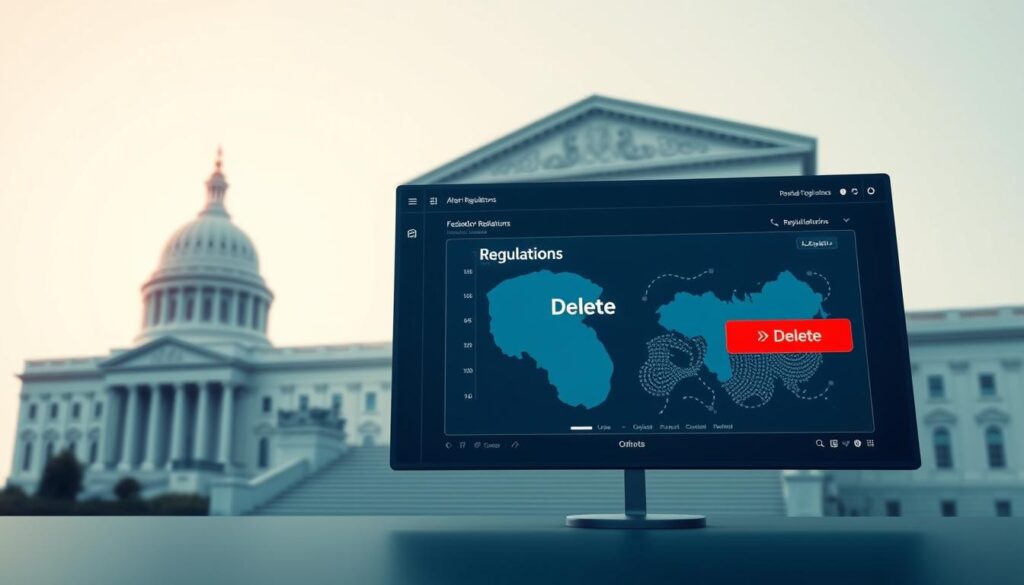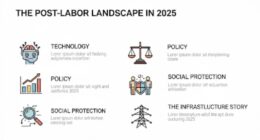In a groundbreaking move, Doge is leveraging advanced AI technology to tackle the challenge of federal regulations. This innovative approach aims to create a ‘delete list’ of outdated or unnecessary regulations, promoting efficiency within governmental policy. As the significance of AI in modern governance grows, Doge’s efforts not only seek to streamline processes but also set a precedent for future regulatory reforms. With the potential for significant impacts on how policies are formed, this initiative stands to reshape the landscape of federal regulation in the United States.
Key Takeaways
- Doge utilizes AI to streamline federal regulations.
- The innovative ‘delete list’ concept aims to remove unnecessary policies.
- AI is increasingly important in modern governmental policy-making.
- This initiative could lead to more efficient regulatory processes.
- Doge sets a new standard for the integration of technology in governance.
The Rise of AI in Government Processes
As digital transformation continues to permeate various sectors, AI in government has emerged as a powerful tool capable of reshaping how policies are drafted and implemented. This technology enables governments to leverage data more effectively, leading to improved decision-making and streamlined processes.
How AI is Transforming Policy Drafting
AI enhances policy drafting by providing advanced data analysis capabilities. Through machine learning algorithms, governments can analyze vast amounts of public and historical data, uncovering trends and insights that guide policy decisions. The speed of AI-driven analysis reduces the time traditionally spent on drafting, allowing for a more agile response to societal needs.
Examples from Other Government Initiatives
Various governmental initiatives have demonstrated the potential of AI tools in public services. For example, cities in the United States have implemented AI systems to optimize traffic patterns, resulting in reduced congestion and improved safety on the roads. These examples reflect broader applications of AI, showcasing its role in enhancing operational efficiency while fostering better public engagement.

Doge’s Innovative Approach to Regulation Cuts
Doge is pioneering an innovative method to streamline federal regulations through the concept of a ‘delete list.’ This approach focuses on identifying regulations that are outdated or unnecessary, using a sophisticated AI strategy for data analysis. By compiling a targeted list of regulations for potential removal, Doge aims to enhance efficiency within the government.
An Overview of the ‘Delete List’ Concept
The ‘delete list’ serves as a critical element in the mission to achieve regulation cuts without impairing essential governance operations. Through the use of AI, Doge examines the landscape of federal regulations, pinpointing those that hinder productivity or create unnecessary burdens on citizens and businesses. This process not only highlights areas for improvement but also supports the objectives of cost reduction and simpler bureaucratic processes.
Potential advantages of implementing the delete list include significant time savings for both regulators and the public. By removing regulations that no longer serve their intended purpose, Doge’s strategy can lead to a more agile government, ready to adapt to changing societal needs. This demonstrates the transformative impact of innovative tools and approaches in modern governance.

Doge reportedly using AI tool to create ‘delete list’ of federal regulations
Doge is leveraging an advanced AI tool to compile a ‘delete list’ of federal regulations. This innovative approach aims to streamline government processes by identifying regulations that may hinder efficiency. The AI tool analyzes various data points to determine which regulations are redundant or outdated, paving the way for potential policy reform.
This project focuses on several criteria including the impact of regulations on economic growth, public safety, and overall governmental effectiveness. By employing such criteria, Doge seeks to ensure that the regulations slated for elimination are those that no longer serve their intended purpose.

Key stakeholders play a crucial role throughout this process. Engagement with lawmakers, industry representatives, and the public helps shape the goals of the delete list initiative. Insights and feedback from these groups contribute to a more comprehensive understanding of which federal regulations need reform.
As the project unfolds, the focus will be on addressing anticipated challenges such as pushback from entities benefiting from existing regulations. The utilization of this AI tool signifies an important step toward a more efficient regulatory environment, reflecting a modern approach to governance.
The Role of AI in Federal Regulation Reform
AI is making significant strides in the context of federal regulation reform, with a pronounced influence on enhancing the efficiency of government policies. By automating various processes, AI can eliminate redundancies and allow for a more dynamic regulatory environment.
Efficiency and Streamlining Government Policies
Implementing AI in regulation reform brings unparalleled efficiency to government operations. Through data analysis and machine learning, AI identifies areas where policies can be optimized. This results in streamlined processes, lowering the costs associated with compliance and regulatory oversight. Moreover, such improvements enable agencies to respond faster to emerging issues, adapting policies to current societal needs.
Potential Impact on Bureaucratic Procedures
The incorporation of AI technology is poised to revolutionize existing bureaucratic structures. By minimizing manual interventions, AI reduces the likelihood of delays often caused by extensive paperwork and approval chains. Enhanced data accessibility and automated workflows promote transparency in decision-making, fostering a more accountable government. The transition toward AI in regulation reform offers a promising future, characterized by reduced bureaucracy and increased policy effectiveness.

Challenges and Controversies Surrounding AI Usage
As AI technology becomes increasingly integrated into government policy making, a range of challenges and controversies has emerged. AI challenges stem from both the technical limitations of AI systems and the broader implications of their use. Ethical concerns arise particularly in the context of algorithmic bias, which can skew decision-making processes. Transparency and accountability in how AI systems operate remain significant issues. These factors shape the public perception of AI in government, influencing how citizens view its role in policymaking.
Ethical Concerns in Policy Making
Ethical concerns about AI usage focus primarily on the potential biases entrenched within algorithms. When these systems are employed in government policy, they can inadvertently reinforce existing inequalities. Lack of human oversight in decision-making exacerbates these issues, raising alarms about accountability. The complexity of AI systems can make it challenging to understand, leading to calls for clearer governance frameworks to ensure ethical standards are upheld in government policy.
Public Perception of AI in Government
Public perception plays a crucial role in shaping the future of AI implementations in government policy. Many citizens express apprehension regarding transparency and the accountability of AI systems. Furthermore, fears about job displacement due to increasing automation fuel skepticism about AI’s role in public service. Engaging with the public to foster understanding and build trust is essential for the successful integration of AI technologies. Addressing these concerns can enhance collaboration between government agencies and the communities they serve.

Implications for the Future of Governance
The integration of AI within government processes paves the way for significant advancements in future governance. As AI implementation evolves, a broad spectrum of opportunities emerges, allowing various branches of government to enhance functionality and engagement. The vision for future governance includes systems that not only streamline regulatory processes but also foster greater civic interaction.
Potential for Broader Implementations in Government
Envisioning AI’s potential in government reveals multiple areas ripe for innovation. From administrative tasks to public engagement platforms, AI can transform operational efficacy. Possible applications include:
- Smart Policy Analysis: AI algorithms can analyze vast amounts of data to identify effective policy measures.
- Public Feedback Systems: AI-driven tools can gather and analyze citizen feedback, enhancing participatory governance.
- Resource Management: Implementing AI can lead to better allocation of government resources, ensuring effective service delivery.
Lessons Learned from Current AI Applications
Reflecting on the lessons learned from current AI applications is vital for guiding future governance strategies. Successful implementations reveal the significance of:
- Transparency: Clear communication about AI’s role and processes promotes trust among citizens.
- Ethical Standards: Establishing guidelines for AI use is crucial to mitigate biases and uphold integrity in decision-making.
- Continuous Improvement: Adapting to feedback and learning from past implementations can guide optimal AI functionality in governance.

Conclusion
The exploration of AI governance through Doge’s innovative initiatives presents a significant advancement in regulatory reform. By leveraging artificial intelligence to create a framework for cutting federal regulations, Doge not only demonstrates the effectiveness of technology in improving government processes but also highlights the potential for more streamlined and efficient administration. The integration of AI into policymaking represents a forward-thinking approach that can reshape how regulations are approached and implemented.
However, as we embrace these technological advancements, it is crucial to remain vigilant about the associated ethical concerns. Ensuring that AI-driven policies do not inadvertently neglect public sentiments or undermine democratic processes will be essential. Dialogue surrounding the implementation of AI in governance must include diverse perspectives to foster a more inclusive and equitable system.
Looking ahead, the experience gained from Doge’s AI initiatives can guide other government entities to adopt similar strategies for transformation. The future of AI in governance will likely revolve around an emphasis on innovation balanced with ethical considerations, allowing for exciting prospects while still addressing the complexities of the human experience. As these discussions continue, the landscape of governance will evolve, offering opportunities that could redefine the relationship between technology and public policy.









